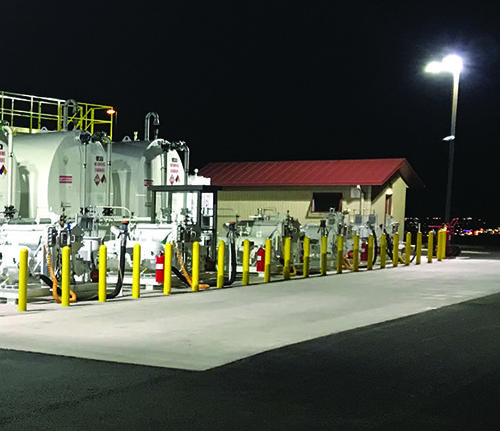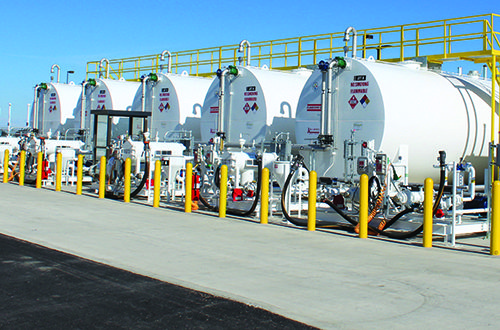A new fuel farm at Great Falls International (GTF) is providing additional fuel capacity, faster delivery and peace of mind about protecting the pristine environment that surrounds the Montana airport. The aboveground facility, which was commissioned in January, replaces a series of underground tanks installed in 1974.
 A new fuel farm at Great Falls International (GTF) is providing additional fuel capacity, faster delivery and peace of mind about protecting the pristine environment that surrounds the Montana airport.
A new fuel farm at Great Falls International (GTF) is providing additional fuel capacity, faster delivery and peace of mind about protecting the pristine environment that surrounds the Montana airport.
The aboveground facility, which was commissioned in January, replaces a series of underground tanks installed in 1974. The new farm includes seven double-walled tanks with a combined capacity of 180,000 gallons; the older units could hold a total of 160,000 gallons. A new backup power supply provides operational assurance.
“We’re thrilled to have modern infrastructure that we know can safely deliver fuel to the commercial airlines, general aviation community and military for many years to come,” says Airport Director John Faulkner. “It’s a real sigh of relief to have such reliability in place that we can all count on.”
|
Project: New Fuel Farm Location: Great Falls (MT) Int’l Airport Farm Owner: Holman Aviation Total Capacity: 180,000 gallons Configuration: Five 30,000-gallon jet fuel tanks; one 15,000-gallon Avgas tank; one split tank for 10,000 gallons of diesel fuel & 5,000 gallons of unleaded auto gas Construction: 3 months Commissioned: Jan. 2019 Design & Construction: American Environmental Aviation Tank Manufacturer: J.L. Houston Co. Electrical: Liberty Electric Overfill Protection System: Scully Electronic Tank Gauging System: Omntec Trench Drain: ABT Inc. Specialty Under Slab Fittings: Nyloplast Key Benefits: Increased storage capacity; faster delivery; backup power system; enhanced spill containment & overfill protection |
Holman Aviation, the airport’s principal fixed base operator (FBO), privately financed the project. Construction took three months.
Long Time Coming
Given the age of the previous storage tanks, discussions about a new fuel farm had been brewing for at least a decade. “The tank farm had modifications over the years to comply with environmental regulations, but the system was clearly very dated,” relates Dwight Holman, president of Holman Aviation. “And we started wondering how we would know if we were at the end of life of an underground fuel system. We certainly didn’t want to wait until we had a leak.”
Holman consequently worked with the airport to select a site, facility design and contractor; and construction began adjacent to the old tank farm in fall 2018. Crews installed seven new tanks: five 30,000-gallon tanks for jet fuel (including one for JP-8 military jet fuel); one 15,000-gallon tank for Avgas; and one interior-split tank that can hold 10,000 gallons of diesel fuel and 5,000 gallons of unleaded gasoline for automobiles.
The new facility includes an asphalt/concrete pad to minimize contamination from potential spills—a high priority for Holman, as two delivery-related spills in the last few years have left him understandably skittish. Fuel from the spills seeped through the pea gravel mixture that covered the previous tanks and entered the soil. “It was very difficult to clean up,” he recalls. “The contaminated soil had to be removed and replaced with clean soil.” In both cases, the truck delivery companies executed and paid for the cleanup.
The airport’s new farm was constructed on a hard surface that is surrounded by a retaining wall. In addition, the surface slopes toward a common drain to capture any spills. “The drain is always kept closed,” notes Holman. “That way, if something were to fail in the system when we are not there, when we are taking delivery of fuel or filling up our mobile refuelers, it will all be retained.”
He’s also more confident that if a spill would occur at the new farm, cleanup would be simpler and faster. Previous spills at the former facility required years of soil and groundwater monitoring.
Updated Features
The farm was designed and constructed by American Environmental Aviation to provide faster flow rates. Jet fuel now pumps at 300 gallons per minute, Avgas at 200 gallons per minute, and automotive fuel at 100 gallons per minute. “The increased pumping speed at the new facility reduces and even eliminates late fuel deliveries to planes,” reports Paul Sundby, vice president at American Environmental Aviation.

There is also a reduction in fuel delivery costs, due to notably faster offloading times, adds Holman. The primary company that delivers fuel to the airport has a specific line item on its invoices that documents the amount of time required to deliver each load of fuel.
The facility includes a secondary overfill protection device to prevent spills if the shutoff device on a refueling truck malfunctions. Although this feature is not currently required, Sundby reports that it will be mandated in several years. “This is an environmentally protected area, as the Missouri River goes right through Great Falls,” he notes.
In addition to faster pumps and overfill protection, the new farm has a backup generator designed to automatically kick in during a power outage. “The old fuel farm did not have a backup generator or backup electricity,” says Holman. “When we experienced a power outage at the farm, we did not have access to fuel beyond what was already in the trucks; yet the airport continued operating. The generator is another huge step forward.”
From a supply point of view, the facility includes an electronic tank gauging system. “This is connected to our computer network so we can easily access our inventories,” he explains.
New Ownership Arrangement
On paper, the new fuel farm represents a change in guard at the airport. Previously, GTF owned the underground tanks, and Holman Aviation owned the aboveground equipment such as pumps. The new farm is completely owned by Holman.
“Like many airports, we ended up owning the tanks at the old farm. But the fuel was delivered under the supervision of the FBO, it was pumped by the FBO, and some of the fuel was even owned by the FBO,” Faulkner relates. “It wasn’t our team that was taking care of it every day. We never touched the fuel or even used the fuel farm. It clearly wasn’t the best system, liability-wise, for the airport.”

Having Holman Aviation own the fuel farm makes much more sense, he reasons. “It’s really a better matching of commercial opportunity and responsibility for the tanks,” says Faulkner.

The old fuel farm is in the process of being decommissioned. Holman is responsible for removing the aboveground equipment it owns, and the airport is securing estimates to remove the underground tanks. Faulkner reports that tank removal is expected to cost about $300,000.
To support Holman Aviation’s investment in the fuel farm, GTF consolidated all of the FBO’s leases with the airport into one master lease and extended it by an additional 15 years.
Racing Winter
The airport’s northern location and proximity to the Rocky Mountain Front made it important for crews to monitor weather conditions throughout construction. Fortunately, last autumn brought little rain. But crews had to finish certain tasks before winter arrived. “We raced against time to get the asphalt and concrete in before the cold weather came and shut down the plants,” recalls Sundby. “After a moderate fall, we did have a little snow. But we got lucky: The severe cold snap, when the thermometer hit 27 degrees below zero, didn’t come until a week after we finished. And despite those temperatures, the fuel farm worked really smooth.”

 Danny Hirschberger, president of American Environmental Aviation, characterizes the project at GTF as relatively straightforward, with a smooth permitting process and no significant construction problems. “Plus, we were very fortunate to have good subcontractors,” he notes. “By the time the trigger was pulled, we were able to make the project happen on schedule.”
Danny Hirschberger, president of American Environmental Aviation, characterizes the project at GTF as relatively straightforward, with a smooth permitting process and no significant construction problems. “Plus, we were very fortunate to have good subcontractors,” he notes. “By the time the trigger was pulled, we were able to make the project happen on schedule.”


 facts&figures
facts&figures

